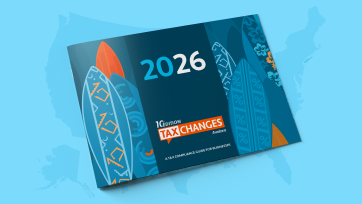
What happens if I charge the wrong sales tax rate?
Sales tax compliance is a complicated issue for businesses, starting with sales tax collection. Different products and services are taxed at different rates. Rates also vary from state to state, county to county, and city to city.
Depending on jurisdictional borders, you can even have differing rates on the same street. For instance, in towns like South Lake Tahoe, California, and Wendover, Utah, it isn’t just the presence of casinos that change when you drive down their streets to Nevada; the sales tax rates and jurisdictions also change.
Because jurisdictional borders are drawn at multiple levels of government, even regional retailers with multiple locations can struggle to determine how much sales tax to collect. And if you're an online retailer? You’ll need to figure out the correct sales tax rate to charge for each transaction based on local sales tax regulations.
For many retailers, determining rates for each sale can feel like too much. While it may be tempting to just use an average rate and call it good enough, that’s not how sales tax collection works.
So let’s talk about the challenges of charging the right sales tax rate, including:
What happens if I undercharge sales tax to my customers?
Sales tax is a pass-through charge. The customer pays the tax, but businesses are responsible for sales tax collection on behalf of the government and remitting the tax collected to the proper tax authority. It’s not up to retailers or service providers to determine the tax rate customers pay, so undercharging sales tax means any sales tax shortage will be paid out of your bottom line.
With each undertaxed sale, you accrue a debt to the tax department. After you file sales tax returns, any missing amount must be paid when you collect and remit sales tax to the tax authorities. Though the numbers can be obscured at the time of filing returns, if (read: when) your business is audited, that bill will come due.
In the best case scenario, an auditor will discover the missing sales tax and issue a bill for the back taxes, clearing up the debt. But missing tax dollars can be compounded if an auditor conducts a sample audit. For example, auditing a two-year period by using a representative sample of transactions from say, a specific quarter.
The assumption is that accounting practices are consistent. So if you’re short on sales tax during the sample quarter, the shortfall is extrapolated across the remaining seven quarters. Meaning every missing dollar for the audited quarter becomes eight dollars in unpaid tax across the audit period. Multiplied across total missing taxes, that bill can add up quickly.
On top of collecting the missing tax, a tax department can impose interest, fines, and civil penalties on any late or unpaid sales tax. Egregious violations of tax laws can result in the revocation of a sales tax license or a sales tax permit, or even lead to criminal penalties for those responsible.
What happens if I overcharge sales tax to my customers?
In light of the steep consequences for undercharging sales tax, it may be tempting to just figure out the highest rate and apply that across the board.
Well, don’t.
Overcharging sales tax is illegal and can even result in criminal charges, especially if any of the excess stays with your business when you remit sales tax.
In addition to legal troubles, collecting too much sales tax can lead to unhappy customers. Never underestimate the number of eagle-eyed consumers who will notice a too-high tax rate.
If you do charge more sales tax than necessary, you’re responsible for refunding the excess to the customer. For some retailers, it can be as simple as reviewing and correcting past invoices and issuing a refund or credit. Even then, it means pulling staff away from normal tasks to rectify accounting errors. There’s no generating revenue in that. And these businesses will probably still have to placate some grumpy customers and work to restore trust.
Correcting the issue gets even more complicated for consumer retailers, especially those with multiple locations and cash transactions. Without a customer database or invoice history to work from, the only recourse is to request customers return to collect a refund.
From the customer point of view, that’s mighty inconvenient. No one wants to pay too much on purchases. Not only have they been overcharged, but in order to get their own money back, they have to take time out of their day to return to the store and wait in line for a refund. And that’s assuming they kept the receipt. If it's only a few bucks for sales tax, many customers are forced into a position to choose between principle and practicality. In either case, you might have lost a loyal customer.
While overcharging sales tax to consumers may not lead to the same sales tax penalties and fees the government charges for missing sales tax, failing to charge the correct rate can result in negative press and damage to your brand’s reputation and loss of customers to other retailers.
How do I determine the correct sales tax rate?
There are multiple factors when determining proper sales tax collection, including:
- State rates
- Local rates
- Product taxability
- Customer exemptions
- State sales tax holidays
With the exception of Alaska, Delaware, Montana, New Hampshire, and Oregon, all states impose a state sales tax rate. Those rates range from 2.9% (Colorado) to 7.25% (California). In 37 states, including Alaska, local jurisdictions can also impose their own sales tax. These rates vary from .026% in parts of Idaho to 5.289% in parts of Alabama.
States and local jurisdictions also have their own taxability rules for exemptions and reduced sales tax rates. Groceries are a common example. Most states, like New York and Washington, don’t charge sales tax on groceries. However, some states charge a reduced rate, like Missouri and Utah. Others, including Mississippi and South Dakota, apply the full state sales tax rate to groceries.
Even in states with exempt or reduced sales tax rates, what qualifies as groceries varies. Most states tax prepared foods at the full tax rate, but items like candy, soda, tampons, and diapers sometimes follow different state rules for taxability.
Other taxability rules apply to goods and services related to state industry, with special sales tax rates or exemptions carved out for items like agricultural equipment in farming states or jet fuel for airline hubs like Georgia’s Hartsfield-Jackson airport.
Sales tax exemptions for nonprofits, resellers, government agencies, or sales tax holidays are also applied and managed based on jurisdiction regulations and rules, which vary from state to state.
The sheer variety in sales tax laws makes determining sales tax rates for goods and services simple for some retailers but complex for others. If you’re selling a couple of items from a single store, you only need to monitor tax rate changes for those goods and that location.
But online retailers need to calculate rates based on where the customers are. Selling a large catalog of products means updating sales tax rates as they change for each type of item. Opening multiple retail locations can mean accounting for different rates, even within the same ZIP code.
Staying up to date on state and local taxes requires ongoing research and keeping up with tax legislation wherever you do business or have nexus, an obligation to collect and remit sales tax. The process can be time-consuming, but the consequences for getting it wrong can be steep.
How can I make sales tax rate calculation easier?
Few get into business with the intention of managing complex sales tax calculations. There are a few options for simplifying the process:
Tax rate tables — By uploading tax rate tables to your accounting, sales, or billing software, you can automatically apply sales tax at the time of purchase. It’s not a fully automated system, as once the table is downloaded, it won’t update based on legislation and rate changes. Most businesses upload new tables once a month, but if changes occur between your updates, you run the risk of charging erroneous rates.
Another caveat is that most rate tables apply rates based on the average sales tax rate within a ZIP code. Because ZIP codes and tax jurisdictions don’t always line up, this creates another vector for applying incorrect tax rates. It’s important to verify these rates to ensure you’re correctly charging sales tax to your customers.
Third party accountants — Many accountants and firms offer sales tax services to retailers, including item classification and rate determination. These services don’t come cheap, but outsourcing can help you focus on tasks that generate revenue and grow your business. Depending on how complex your business is, it may simply make sense to outsource sales tax compliance, despite the cost.
Sales tax software — You can also implement sales tax software directly within your business systems. Cloud-based solutions like Avalara allow you to apply rates without having to download rate tables. These kinds of platforms can account for state and local tax rates, taxability rules, exemptions, sales tax holidays, and rate fluctuations.
Calculate sales tax with Avalara
Avalara offers tax calculation solutions for a variety of tax types and industries, retail and manufacturing for example, as well as those with special tax rates, like energy, communications, cross-border, and beverage alcohol.
Our platform can help you increase accuracy and improve efficiency over manual processes by using automation to apply regularly updated rates based on taxability and jurisdiction rates.
And with prebuilt integrations and an API, you can incorporate Avalara with the business systems you’re already using.
If you’d like to know how Avalara can help you collect sales tax, contact us today.

Avalara Tax Changes 2026 is here
The 10th edition of our annual report engagingly breaks down key policies related to sales tax, tariffs, and VAT.
Stay up to date
Sign up for our free newsletter and stay up to date with the latest tax news.














